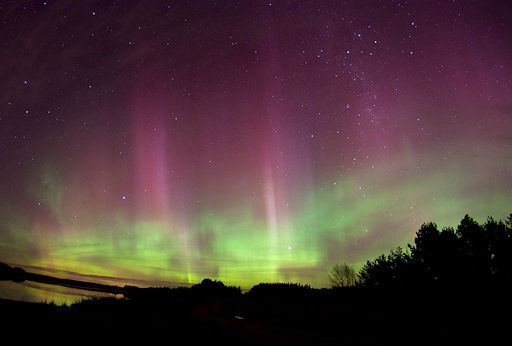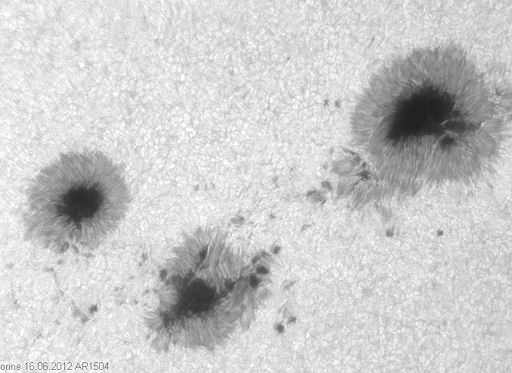GEOMAGNETIC STORM ALERT: A geomagnetic storm is in progress in the wake of a double CME impact on June 16th. The hit, which strongly compressed Earth's magnetic field, lit up both poles with bright auroras. Stephen Voss sends this photo from Southland, New Zealand:
"We enjoyed a beautiful display of the Southern Lights from the south of New Zealand," says Voss. "A dull arc hung around for a couple of hours before suddenly exploding with a mixture of rays and curtains."
Meanwhile, in the Americas, Northern Lights descended as far south as Wisconsin, Minnesota, Iowa, Washington and the Dakotas.
Solar wind conditions in the wake of the CME favor continued disturbances. NOAA forecasters estimate a 55% chance of more high-latitude geomagnetic storms during the next 24 hours. Aurora alerts: text, voice.
Realtime Space Weather Photo Gallery
CHANCE OF FLARES: Sunspot AR1504 has a complex 'beta-gamma' magnetic field that harbors energy for strong solar flares--and the huge sunspot is almost directly facing Earth. Amateur astronomer Eric von der Heyden photographed the behemoth on June 16th from his backyard observatory in Mühltal-Traisa, Germany:
Each of the dark cores in the image is about twice the size of Earth. The sheer size of the complex makes it an easy target for backyard solar telescopes.
NOAA forecasters estimate a 65% chance of M-flares and a 5% chance of X-flares from AR1504 during the next 24 hours. X-flare alerts: text, voice.
Readers, please scan the Realtime Photo Gallery for constantly updated images of this sunspot plus a huge prominence which has popped up on the sun's western limb.

![]()
Solar wind
speed: 432.9 km/sec
density: 15.2 protons/cm3
explanation | more data
Updated: Today at 1656 UT
![]()
X-ray Solar Flares
6-hr max: B7 1014 UT Jun17
24-hr: C1 0157 UT Jun17
explanation | more data
Updated: Today at: 1600 UT
![]()
![]()
![]()
Daily Sun: 17 Jun 12
![]()
![]()
Sunspot 1504 has a 'beta-gamma' magnetic field that poses a threat for strong M-class solar flares. Credit: SDO/HMI
![]()
![]()
![]()
Sunspot number: 110
What is the sunspot number?
Updated 16 Jun 2012
Spotless Days
Current Stretch: 0 days
2012 total: 0 days (0%)
2011 total: 2 days (<1%)
2010 total: 51 days (14%)
2009 total: 260 days (71%)
Since 2004: 821 days
Typical Solar Min: 486 days
Updated 16 Jun 2012
The Radio Sun
10.7 cm flux: 135 sfu
explanation | more data
Updated 16 Jun 2012
![]()
![]()
![]()
Current Auroral Oval:
![]()
Switch to: Europe, USA, New Zealand, Antarctica
Credit: NOAA/POES
![]()
![]()
![]()
Planetary K-index
Now: Kp= 5 storm
24-hr max: Kp= 6 storm
explanation | more data
![]()
Interplanetary Mag. Field
Btotal: 7.9 nT
Bz: 7.5 nT south
explanation | more data
Updated: Today at 1656 UT
![]()
![]()
![]()
Coronal Holes: 17 Jun 12
![]()
![]()
There are no large coronal holes on the Earthside of the sun. Credit: SDO/AIA.






